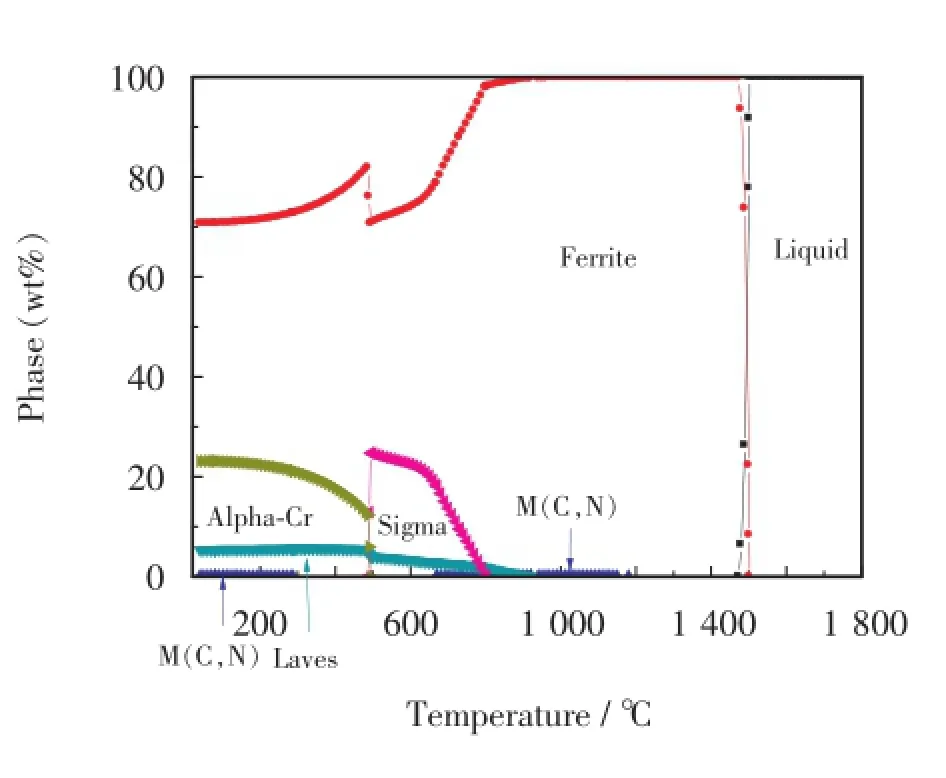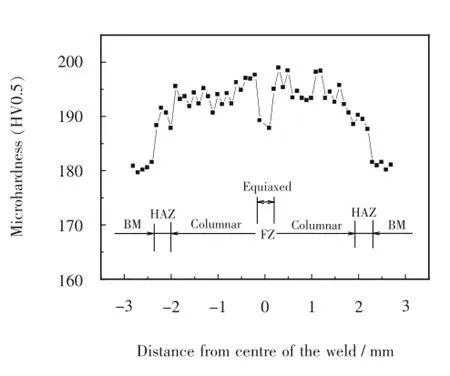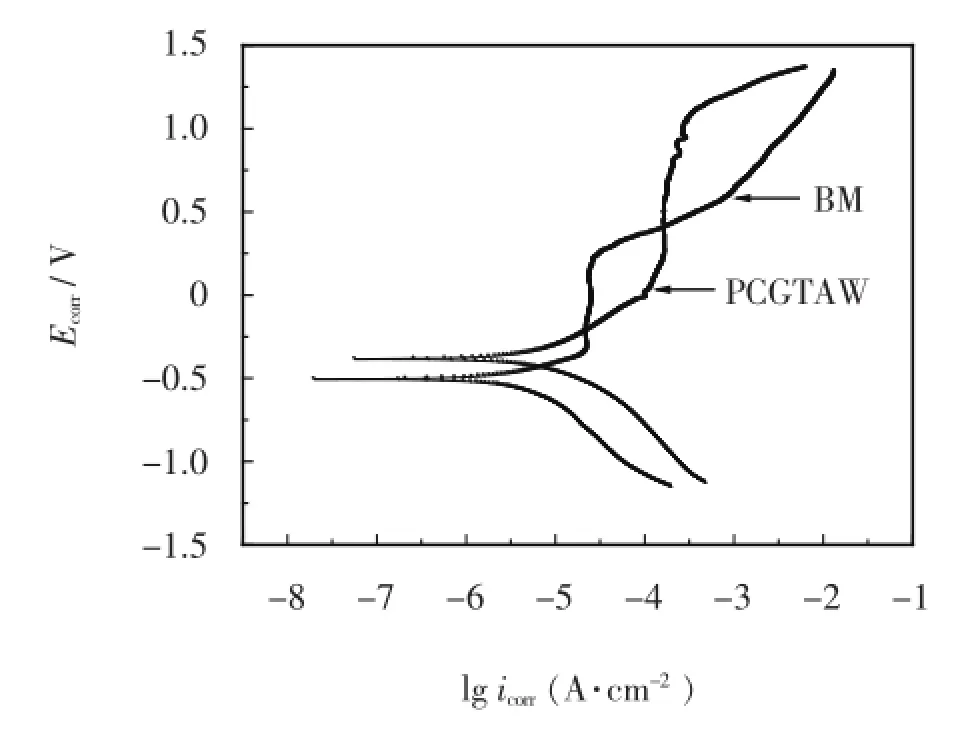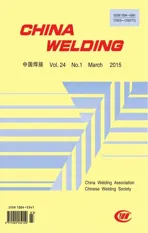Mechanical and corrosion properties of 445J2 ultra pure ferritic stainless steel joint*
2015-09-05ZhangTingtingWangWenxianWangZhibinYanZhifengZhangXinbaoandZhangZhaohan张婷婷王文先王志斌闫志峰张心保张昭晗
Zhang Tingting,Wang Wenxian,Wang Zhibin,Yan Zhifeng,Zhang Xinbao and Zhang Zhaohan张婷婷,王文先,王志斌,闫志峰,张心保,张昭晗**
Mechanical and corrosion properties of 445J2 ultra pure ferritic stainless steel joint*
Zhang Tingting,Wang Wenxian,Wang Zhibin,Yan Zhifeng,Zhang Xinbao and Zhang Zhaohan
张婷婷,王文先,王志斌,闫志峰,张心保,张昭晗**
Themicrostructure,mechanical and corrosion resistance properties of 445J2 ultra pure ferritic stainless steel thin plate joints conducted by the pulsed current gas tungsten arc welding(PCGTAW)were discussed in this paper.In order to avoid weld defects,theappropriate welding processwas adjusted.The jointswere subjected to opticalmicroscopy,transverse static tensile,plastic deformation,intergranular corrosion and electrochemistry corrosion tests.The results indicated that the weld zone(WZ)is characterized with columnar grains and equiaxed grains and the heat-affected zone(HAZ)shows coarse ferrite grains due to the rapid solidification of thin plate welding.The PCGTAW joint exhibited acceptable mechanical properties and equivalent corrosion resistance properties as thebasemetal.
pulsed current gas tungsten arc welding,ferritic stainless steel,microstructure,properties
0 Introduction
445J2 ultra pure ferritic stainless steel(FSS)is one kind of ultra pure ferritic stainless steels developed in recent years,which is fabricated by limiting the carbon and nitrogen element content to a very low level and adding the stabilizing elements,such as Mo,Ti,Nb,V and so on. 445J2 ultra pure FSS exhibits a good machining performance and corrosion resistance performance.Thematerial is suitable for heating equipment,floor heating,solar thermal collectors(coating),and so on.
Fusion welding,due to its flexibility and lower production cost,is widely used for the fabrication and joining of engineering applications[1].However,joining of ferritic stainless steels is faced with the problem of coarse grain in the WZ and HAZ of fusion welding.Meanwhile,the toughness and ductility of FSS would be deteriorated after welding due to the grain growth and the absence of phase transformation[2].
Pulsed current gas tungsten arc welding(PCGTAW),developed in 1950s,is a variant of GTAW which involves cycling of the welding current from a high level to a low one at a selected regular frequency[3].
In the present studies,the process is applied for the welding of aluminum alloy,magnesium-aluminum dissimilar materials more often[3-4].Meantime,the cost of pulsed current technique is lower than that of the high energy beam processes,such as laser and electron beam welding.
Some studieswere reported on microstructure and mechanical properties of FSS joints fabricated by using conventional welding process,such as shielded metal arc welding,gasmetal arc welding,gas tungsten arc welding and electron beam welding processes[5-9].However,these studies are focused on the thick plate and welding fillermaterials.
In this study,microstructure,mechanical properties,and corrosion resistance properties analysis were carried out in order to evaluate the PCGTAW joint performance of 445J2 ultra pure FSS.
1 Experim ental p rocedure
The 0.8 mm thick 445J2 ultra pure FSS plates were used as the base metal.The chemical composition and mechanical properties at room temperature of the basemetal are presented in Table 1 and Table 2.Microstructure of the basemetal is shown in Fig.1.The basemetal presents the fine ferrite grain and themean grain size was about30 μm.Welding parameters were given as follows:the base currentof 40 A,the peak currentof 80 A and the welding speed of 4.75mm/s.

Table 1 Chem ical com position of basemetal(w t.%)
The microstructure examination was carried out by opticalmicroscope.Vicker's microhardness testing machine(HVS-1000A)was utilized for measuring the hardness of the joint,with a 500 g load.The statistic tensile testwas conducted by the CMT5205 microcomputer control electronic universal testingmachine,with the loading velocity of 0.3 mm/min,according to ASTM E8M-04,and the fractured surfaceswere examined by SEM.The erichsen testwas conducted by GBS-60B erichsen tester,with a 10 kN clamping forces.
The 3.5%NaCl solution was chosen as the corrosion medium.The potential was scanned from-1 000 mV to 1 500 mV against SCE at a scan rate of 5 mV/s.In order tomake the corrosion solution in specimens surface stable and uniform,the sampleswere soaked in solution for 3 minutes before the test started.Tafel slopeswere determined by using the CS electrochemical workstation.

Fig.1 Microstructure of the basemetal
2 Results and discussion
2.1Microstructure
Fig.2 shows the equilibrium phase diagram of the 445J2 ultra pure FSS by JMatPro 7.0 calculation.This kind of FSS has no phase change and little second phase particles,during the process of heating and cooling.So themicrostructure evolution of the 445J2 ultra pure FSS is mainly due to the grain growth under the welding thermal cycle.

Fig.2 Phase diagram calculated of 445J2 u ltra pure FSS by JM atPro 7.0 software
Full penetration joints were produced by PCGTAW. Microstructure of the whole joint examined was shown in Fig.3.Fig.4 shows the microstructure within differentzones of the welded joint.The weld zone(WZ)primarily contains both solidified columnar ferrite and equiaxed ferritematrix(Fig.4a and Fig.4b).The heat-affected zone (HAZ)primarily contains coarse grained ferrite microstructure(Fig.4c).The coarse grains are attributed to the existence of temperature gradients and the“thermal pin effect”.From the micrographs in Fig.3,it can be seen that there is an appreciable difference in grain size between the different part of HAZ regions.Peripheral WZ exhibits coarse columnar grains because of the prevailing thermal conditions during weld metal solidification.And the growth direction of columnar is perpendicular to the weld pool boundary because of the highest temperature gradients and the fastestheat dissipation in this direction. Themorphology of equiaxed grains in centre WZ is resulted from the small temperature gradient and the Ti forming refractory compounds that acted as heterogeneous nucleation sites for the grains solidification possibly[10-11]. Hence,the Heyn's line interceptmethod has been made tomeasure the mean grain diameter in the FZ of all the joints[12].The length-width ratio ofmeasured mean columnar grains ofwelded joints is 3∶1.

Fig.3 Microstructuremorphology of the whole joint

Fig.4 Microstructuremorphologies of the differen t region of welded joint
2.2Mechanical p roperties
Themicrohardness across the welded joint cross section wasmeasured,and the results are presented in graphical form as shown in Fig.5.The transverse tensile strength and the forming property of the joints have also been evaluated.In each condition three specimens were tested and the results are mentioned in Table 3.The tensile results show that the yield and tensile strength of welded joint are lower than those of the base metal.The tensile strength,elongation and erichsen value of PCGTAW metal is found to 88.19%,83.73%and 82.6%of the base metal.So the plasticity of the welded specimen ismuch lower,compared with thatof the initial basemetal.This could be due to the appearance of columnarmorphology and the coarse equiaxed grain,which can be explained by the equation of Hall-Petch[13].Decreased plasticity and strength is addedto the vertical growth of columnar grains in the WZ.The columnar structures are anisotropic and the equiaxed structures aremore isotropic.

Fig.5 Microhardness profile show ing Microhardness of d ifferent zones of the welded joint
The fracture took place in the WZ,which is shown in Fig.6.The results show that the base metal presents an obvious necking,butnecking of the welded joint specimen is not obvious.Fig.7 displays the fractographs of tensile tested specimens of the base metal and welded joint.The fractographic features show dimple-ductile fracture(Fig.7a and Fig.7b),which isan indication that the tensile specimens failed in a ductilemanner under the tensile loading. Besides,there were no inclusions in dimples.However,finer dimpleswere observed in the basemetal tensile specimen compared with the welded joints.There were some microscopic pore dimples in basemetal.This could be due to the existence of microscopic pores in the base metal during smelting,and thesemicroscopic pores formed bigger dimples due to the plastic deformation under tensile load.At the same time,the foldsmorphologic characteristic resulted from the deformation of pore walls was formed in dimple walls.A little cleavage facets were observed in the tensile fracture ofwelded joint(Fig.7b).The fracture facet in the weld specimen was columnar and elongated facet,which could be attributed to the columnar and coarse equiaxed grains feature in theWZ comparewith the base metal.

Fig.6 Failure location after tensile test
The resultof erichsen test showed that the plastic deformation of welded joint is lower than that of base metal. This could be attributed to the variation ofmicrostructure morphology in the welded joint.

Table3 Mechanical properties of PCGTAW joint
2.3 Corrosion resistance p roperties
The intergranular crack was not found in fusion line and its surrounding,during the microscopic examinationon the bending specimens surface of weld specimen and the base metal.The result shows that the intergranular corrosion resistance after welding process of 445J2 ultra pure FSS is fairly good,which may result from two aspects:one is the appropriate welding parameters;the other is the higher quantity of Cr,Ti and Cu elements,and the minute quantity of C and N elements in 445J2 ultra pure FSS than other common ferritic stainless steels[14-15].
Fig.8 depicts the potentiodynamic anode polarization curves of the weld specimen and base metal.The measured values of the corrosion potentials,corrosion current and passivation current of the samples are presented in Table 4.

Fig.7 SEM fractographs of tensile specimens
As shown in Table 4,compared to the base metal,the corrosion current(icorr)of the welded joint sample is increased from 2.86×10-6A/cm2to 3.75×10-6A/ cm2,and the passivation current(ip)is increased from 2. 63×10-5A/cm2to 17.02×10-5A/cm2.Therefore,the corrosion resistance of base metal is slightly higher than that ofwelded joint in the NaCl solution.
The difference in corrosion behavior of specimens could be related to the formation of passive layers on the surfaces and their adherence to the substrate[16].The difference of corrosion resistance is related to the burning loss of alloy elements,such as Cr,Mo,Ni and Cu,in welding process.Moreover,the difference of the microstructuremorphology may influence the forming of passive film.The microstructure of the WZ is characterized with the coarse columnar and equiaxed grains.Because of the high-energy of grain boundaries,the formation of passive layer on the finer equiaxed grains of the basemetal sample is easier.So the higher susceptibility of base metal in NaCl solution medium to pitting corrosion is related to its passive film instability.

Fig.8 Potentiodynam ic anodic polarization curvesin 3.5 w t.%NaCl solution

Table 4 The corrosion potential(Ecorr),the corrosion current(icorr)and passivation current(ip)calculated from Fig.8
Fig.9 shows the SEM images of themorphology of the 445J2 basemetal and welded joint in 3.5 wt.%NaCl solution.Both specimens contained some pits,and there are more and bigger pits in the welded joint specimen.This can be attributed to enough Mo(2.37 wt.%)and Cu (0.44 wt.%)in this kind of steel.Because the Cu and Mo can enhance anti-pitting corrosion performance on the ferritic stainless steel under the certain corrosive condition (Mo is less than 5 wt.%,Cu is about0.55 wt.%)[17].The favorable effect of Cr and Mo is related to their bulk concentrations.The property of corrosion resistance as a function of the chemical composition is known and given by the pitting resistance equivalent number(PREN)value[18].

Based on above analysis,the anti-pitting corrosion resistance of the welded joint is equivalent to that of base metal.

Fig.9 SEM images showing themorphology of the 445J2 in 3.5 w t.%NaCl solu tion
3 Conclusions
(1)The results indicated that the weld zone is characterized with columnar grains and equiaxed axial grains. The HAZ shows coarse ferrite grains due to the rapid solidification of thin plate welding.
3.2.2 严密观察患者 护士应经常巡视病房,早发现、早防范有精神异动患者,采取外紧内松的管理模式,做好患者的心理疏导,鼓励患者参加适度的体育锻炼、文娱活动分散患者注意力,不让患者存在自卑;精神异常发作时及时采取约束带和暂时性的保护性隔离措施。
(2)Tensile strength,elongation and erichsen value of PCGTAW metal is found to 88.19%,83.73%and 82.6%of the base metal.The failure location of static tensile test took place in the weld zone.
(3)The fractographic features of the weld specimen and base metal show dimple-ductile fracture,which is an indication that the tensile specimens failed in a ductilemanner under the tensile loading.
(4)The weld specimens of pulsed current gas tungsten arc welded 445J2 ultra pure FSSexhibits the good intergranular corrosion resistance and pitting corrosion resistance,because of the higher quantity of Cr,Ti and Cu,and the minute quantity of C and N elements.
References
[1] Amuda M O H,Mridha S.Microstructure features of AISI 430 FSS weld produced under varying process parameters. International Journal of Mechanical and Materials Engineering,2009,4(2):160-166.
[2] Satyanarayana V V,G.Madhusudhan R,Mohandas T,et al.Dissimilar metal friction welding of austenitic-ferritic stainless steels.Journal of Materials Processing Technology,2005,160(2):128-137.
[3] Kumarl T S,Balasubramanian V,Sanavullah M Y,et al. Effect of pulsed current TIG welding parameters on pitting corrosion behavior of AA6061 aluminum alloy.Journal Material Science Techno1ogy,2007,23(2):223-229.
[5] Guo X M,Liu C S,Yuan JW.Microstructure and mechanical properties of TIG welded-joint of ferritic stainless steel,Journal of Aeronautical Materials,2011(6):57-59.(in Chinese)
[6] Lakshm inarayanan A K,Balasubramanian V.Assessment of sensitization resistance of AISI 409M grade ferritic stainless steel joints using Modified Strauss test.Materials and Design,2012,39:175-185.
[7] Lakshm inarayanan A K,Balasubramanian V,Madhusudhan R G.Microstructure and mechanical properties of electron beam-welded AISI 409M-grade ferritic stainless steel.International Journal Advance Manufacture Technology,2011,55:153-162.
[8] Wang B S,Ma L,Ye X N,et al.Microstructure of 12%Cr ferrite stainless steel in welding heat-affected zone.Journal of Aeronautical Materials,2007(3):70-74.(in Chinese)
[9] Zhang Z C.Study on the ferrite stainless steel 4003 made in Germany.Electric Welding Machine,2008,11(38):42-43,54.(in Chinese)
[10] Villaret V,Deschaux B F,Bordreuil C,et al.Influence of filler wire composition on weld microstructures of a 444 ferritic stainless steel grade.Journal of Materials Processing Technology,2013,213(9):1538-1547.
[11] Han J,Zheng H G,Wu D F,et al.The effect of Ti addition on equiaxed grain formation in ferritic stainless steel welds.Baosteel Technical Research,2010(2):30-34. (in Chinese)
[12] GB/T6394-2002.Metal-methods for estimating the average grain size.Beijing:Standards Press of China,2002.(in Chinese)
[13] Lu J,Zeng X Q,Wen J.The Hall-Petch relationship.Light Metals,2008(8):59-64.(in Chinese)
[14] Liu S H,Wang Y J,Quan W W.Welding procedure of JYH21CT ferrite stainless steel.Electric Welding Machine,2009,39(1):30-32.(in Chinese)
[15] Kim JK,Kim Y H,Lee JS,et al.Effectof chromium content on intergranular corrosion and precipitation of Ti-stabilized ferritic stainless steels.Corrosion Science,2010,52:1847-1852.
[16] Eskandari M,Yeganeh M,Motamedi M.Investigation in the corrosion behaviour of bulk nanocrystalline 316L austenitic stainless steel in NaCl solution.Micro&Nano Letters,2012,7(4):380-383.
[17] Liu JM,Liang JY.Effect of alloy elementson corrosion resistance of ferritic stainless steel.Shanxi Metallurgy,2005 (4):9-12.(in Chinese)
[18] Chris X,Krista V B,Henri D.Electrochemistry:a powerful analytical tool in steel research.Electrochimica Acta,2004,49(17-18):2825-2831.
*Thiswork was supported by the Natural Science Foundation of Shanxi Province of China(2013021021-1),and the Graduate Innovation Project of Shanxi Province of China(20123031).
**Zhang Tingting,WangWenxian,Yan Zhifeng and Zhang Zhaohan,College of Material Science and Engineering,Taiyuan University of Technology,Taiyuan,030024. Wang Zhibin and Zhang Xinbao,Taiyuan Iron&Steel(Group)Company Lim ited,Taiyuan,030003. WangWenxian,Corresponding author,E-mail:wangwenxian@tyut.edu.cn
猜你喜欢
杂志排行
China Welding的其它文章
- A Fe-Ni-Cr system filler metal for brazing of stainless steel*
- Numerical analysis of thermal process in continuous drive radial friction welding*
- Effect of refilling time on Microstructure and Mechanical properties of friction spot welded LY12 alum inum alloy*
- Simulation of phased array S-scan acoustic field in FSW joint of alum inum alloy extrudate w ith com p lex shape*
- Simulation on the deformation controlling of T-joint LBW w ith auxiliary heat source for high strength alum inum alloy*
- Analysis of grain grow th in hybrid weld HAZ based on the coupled thermo-fluid model
